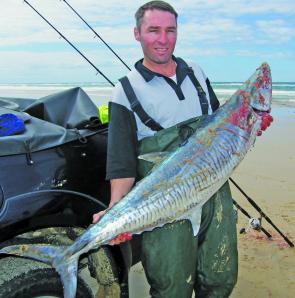Wow! What a tailor season it has been on Fraser’s ocean beach. And it should continue well into this month with some of the better quality fish being beached.
The overall quality of this year’s catch has been down on previous seasons. However, I don’t think that you can really read anything into this as each season is variable as far as quantity and quality are concerned. One of this year’s bonuses has been that the tailor have been widely distributed along most of the ocean beach. In 2009 there was an obvious concentration of fish between the Maheno and Dundubara but that has not been the case this year.
The other regular beach species have been available throughout the tailor season. A recent return to form of sand whiting has been welcomed by light tackle specialists. Often the best catches are being made at the blind ends of classic tailor gutters. Sand patches between coffee rocks at Yidney and Poyungan are also producing some good fish.
Whiting fishers are often heard to debate the relative merits of sea worms and pipis. Although sea worms, through ease of use and ability to stay on the hook, may account for the numbers, pipis invariably account for the better quality specimens.
Pipis are abundant right along the beach but they might not be readily seen by the tell-tale mounds. Only in certain tidal conditions do they move in with the tide to bury in what becomes low tide beach and it is then that their locations become obvious. In different tidal conditions they might stay down in the wash, not always advertising their presence. Sometimes the projecting feeding tubes can be seen in a receding wave and this can make gathering easy. Most beach anglers would be familiar with the pipi ‘shuffle’ where the shellfish are located by awkward gyroscopic motions of feet, legs and torso.
Pipis can be so abundant that sadly many people get carried away and collect more than they can use. A bag limit of 50 (in possession) applies but many legal buckets of pipis are neglected and end up being discarded as a stinking mess of half-open shells. Keeping pipis healthy involves keeping them in small numbers in the shade with frequent saltwater changes. I use shallow trays rather than conventional buckets as the greater surface area gives more opportunity for aeration.
Of course pipis also make good tucker. One of our recent guests, in training for Master Chef I think, produced a batch of pipi fritters that were truly to die for. For our original islanders, pipis (or wongs as they knew them) were an important food source and you can see evidence of this in many of the island’s kitchen middens.
What must rate as one of the most remarkable captures on Fraser Island’s ocean beach was that of a 21kg Spanish mackerel recently. Ivan Kosic and his mates were spinning for tailor near Poyungan Rocks. Remarkably this was just one of three Spaniards each over 10kg taken during the week. The boys were using metals with the big specimen unable to resist an 85g Raider. I have been fishing the island regularly for over 40 years and have never seen anything like this – if there were records, it would have to be right up there for a mackerel taken off the open beach.
However, Spanish mackerel and a number of other large predators are known to be prone to ciguatera poisoning, particularly in the Platypus Bay area off Fraser’s northwest coast, so much so that Spaniards from here are not accepted from commercial fishers. Now it is not inconceivable to propose that such a fast swimming fish could be off Poyungan soon after being in Platypus Bay. I would certainly be hesitant to chow down.
The toxin responsible for ciguatera poisoning has its origins in a marine alga, a food source for animals low in the food chain. This alga is thought to be in high concentrations in and around Platypus Bay. As the toxin passes along the food chain, through biological magnification, its concentration increases and so in the large predators high in the chain, there may be sufficient toxin to be a major problem.
Ciguatera, its symptoms and effects, other testing methods and its worldwide distribution make interesting reading. I suggest that you Google ciguatera then settle in for lots of interesting information.
Prospects for November are looking good for the ocean beach. With the weed, which plagued the east coast of the island for years, apparently out of the picture, there should be no shortage of all the popular species including the last of the spawning tailor.
At this time of the year we can expect those nasty northerlies that Hervey Bay fishers detest. However on the ocean beach south of Indian Head they are mostly offshore and make for fairly calm conditions. In recent editions I have dealt with some of the options on the west coast between Woralie Creek and Moon Point. Particularly if the northerlies are blowing, I suggest giving these spots a big miss this month. These winds are also associated with the annual build up of weed along much of the western shoreline north of Moon Point.
Reads: 4173
A fantastic 21kg Spanish mackerel caught by Ivan Kosic near Poyungan Rocks recently while spinning for tailor using 85g Raider.




